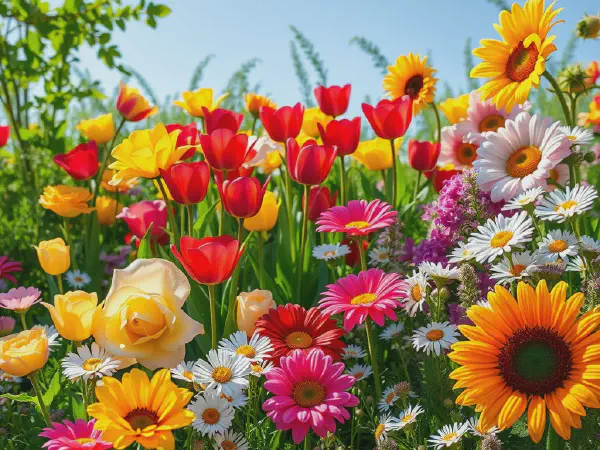Explore Various Types of Flowers for Every Garden

Exploring the Diverse Types of Flowers
Flowers are an essential part of the plant kingdom, representing beauty, color, and the wonders of nature. From vibrant annuals to resilient perennials, the types of flowers vary widely, catering to different gardening preferences and landscape designs. This article delves into the fascinating world of types of flowers, highlighting their characteristics, care needs, and ornamental value. Understanding these types can transform any garden into a blooming paradise and provide insight into which flowers best suit your gardening style.
The types of flowers can generally be classified into several categories: annuals, perennials, flowering shrubs, wildflowers, and tropical flowers. Each category showcases a unique blend of colors, fragrances, and aesthetic appeal. Annual flowers complete their life cycle in one growing season, while perennials return year after year. Flowering shrubs expand the garden’s structure, creating focal points, while wildflowers offer a natural, untamed look. Tropical flowers, with their exotic appeal, provide a splash of the tropics in suitable climates or indoor environments. This diversity allows gardeners to experiment and choose flowers that enhance their outdoor spaces.
When considering the types of flowers, it is important to take into account the growing conditions, such as sunlight, soil type, and water availability. Some flowers thrive in full sun, while others prefer partial shade. Understanding these needs ensures successful growth and blooming of the plants. Additionally, varying types of flowers can attract different wildlife, including bees and butterflies, promoting a healthier ecosystem. Therefore, choosing the right types of flowers is not just about aesthetics; it also involves environmental considerations.
The care required for different types of flowers also varies significantly, from watering frequencies and soil types to fertilization and pruning techniques. Before planting, it's essential for gardeners to research the specific needs of each type of flower. Seasonal maintenance ensures that the plants remain healthy and vibrant throughout their growing period. Moreover, pairing compatible flowers can enhance both the visual appeal and health of the garden, making the flower arrangement more harmonious and thriving.
In summary, the types of flowers encompass a vast array of choices that cater to all gardening levels and styles. Whether you are drawn to the bright colors of annuals, the stability of perennials, or the striking appearance of tropical flowers, understanding their unique characteristics helps in creating a successful and beautiful garden. By appreciating the diversity within the flower kingdom, gardeners can make informed decisions that align with their aesthetic preferences and ecological sustainability.
Annual Flowers
Annual flowers are a popular choice for many gardeners due to their vibrant blooms and the ability to produce flowers from spring to fall in a single growing season. Some of the best annual flowers for sunny areas include petunias, marigolds, and zinnias. These flowers thrive in full sunlight and add lively colors to any landscape, making them ideal for garden beds, borders, and pots.
Caring for annual flowers involves regular watering and deadheading to encourage further blooming. They typically benefit from fertilization every few weeks during the growing season to maintain their vigor and flower production. Ensuring proper spacing between plants promotes air circulation and reduces the risk of disease.
Popular annual flowers for beginners include sunflowers and cosmos. These flowers are easy to grow from seeds, requiring minimal care. Their resilience to varying weather conditions makes them suitable for novice gardeners looking to add vibrant colors to their gardens without extensive horticultural knowledge.
Perennial Flowers
Perennial flowers are cherished for their ability to return season after season, creating long-lasting displays in the garden. Types of perennial flowers with long-lasting blooms include coneflowers, daisies, and daylilies. They offer stability and structure, making them valuable additions to any garden design.
Care tips for perennial flowers include dividing them every few years to maintain plant health and vigor. Regular watering during dry spells, along with the application of mulch, can help retain soil moisture and suppress weeds. It's also important to cut back spent blooms to encourage new growth and maintain a tidy appearance.
When planting perennial flowers, consider grouping them based on their bloom times to create a vibrant garden throughout the seasons. Also, incorporating various heights and colors can enhance the visual appeal, attracting pollinators and creating a lively ecosystem in your garden.
Flowering Shrubs
Flowering shrubs play a significant role in garden design, offering structure and seasonal interest. Some top flowering shrubs for your landscape include hydrangeas, azaleas, and roses. These plants can serve as beautiful borders, hedges, or focal points within garden beds, adding depth and dimension to the overall design.
To properly care for flowering shrubs, regular pruning is essential for promoting healthy growth and encouraging more blooms. Additionally, providing adequate water and nutrients, particularly during the blooming season, ensures that the shrubs remain vibrant and lush. Monitoring for pests and diseases is also an important part of shrub upkeep.
Seasonal flowering shrubs to consider include forsythia and lilacs, which bring vibrant colors in early spring. Choosing a mix of shrubs that bloom at different times will maintain visual interest throughout the year and create a beautiful landscape that evolves with the seasons.
Wildflowers
Wildflowers are a delightful way to introduce a natural style to your garden. Types of wildflowers native to different regions include black-eyed Susans, bluebells, and prairie clovers. These flowers are well-adapted to local soil and climate conditions, making them easier to grow and maintain while also supporting local wildlife.
To cultivate wildflowers, prepare the soil by removing weeds and debris, then scatter the seeds and lightly rake them in. Wildflowers typically require less maintenance than traditional garden flowers; however, periodic watering during dry spells may be necessary. It’s also important to allow some wildflowers to go to seed to ensure they return in future growing seasons.
The benefits of planting wildflowers in your garden include attracting pollinators and providing a habitat for beneficial insects. Additionally, wildflowers can reduce the need for lawn maintenance and chemicals, promoting a healthier environment while adding stunning visual appeal to your landscape.
Tropical Flowers
Tropical flowers are often celebrated for their striking beauty and vibrant colors, making them perfect for warm climates and indoor decorations. Some of the best tropical flowers for warm climates include hibiscus, orchids, and birds of paradise. These species thrive in sunny, humid conditions, adding an exotic touch to gardens and landscapes.
Caring for tropical flowers indoors requires specific attention to light and humidity levels. Placing tropical plants near south-facing windows can provide adequate sunlight, while regular misting can help maintain humidity. Fertilizing during the growing season supports healthy growth and flowering.
Unique tropical flower species to grow include the anthurium and plumeria. These flowers not only offer stunning displays but also introduce exotic scents to your indoor spaces or outdoor gardens. Growing tropical flowers can be a rewarding experience, bringing a piece of paradise into your home.
